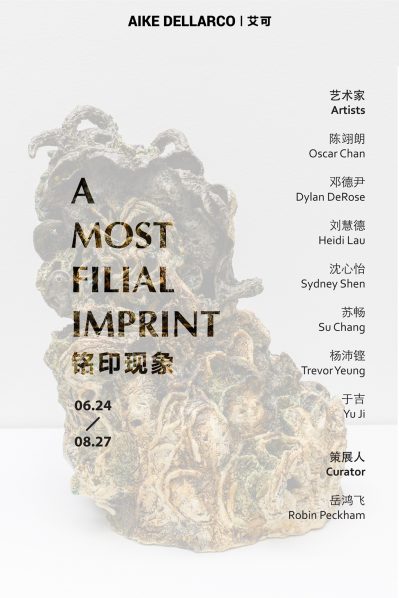
During a critical period after hatching, baby birds of certain species imprint themselves on the first moving stimulus they encounter, be it the mother duck or a pair of galoshes. Art objects, in some ways, are a little bit like baby ducklings that imprint themselves on their makers during a certain critical period of birth and rearing. Filial imprinting marks the moment at which nature and nurture function as one. This exhibition examines a particular form of art-making in which the object is shaped twice by the body of the artist: first when the body gives conscious or expressive form to the material of the object, and then again when the object absorbs the unintentional traces of the body along the seam between the surfaces of both. Heat, basal metabolism, skin, fingerprints, time, humidity; these are the terms through which the object imprints itself on its author.
The space of the exhibition is defined by a series of low columns. Half are pedestals supporting the work of New York-based Macanese sculptor Heidi Lau (1987), whose ceramics draw on the mythologies of multiple cultures, biomorphic architecture, and nature in popular culture. Appearing extravagant and gothic in form, the level of detail in her sculpture is overwhelming, and the hand is present at every turn. The other half of the columns are the plaster sculpture of Shanghainese artist Su Chang (1985), who works in the footsteps of Robert Gober by creating things that look visually indifferentiable from ready-mades. Rather than found objects, however, his stacks of tiles are actually modular plaster casts, universal forms that wrestle with retaining or jettisoning the handiwork of the artist.
Several large wall faces are given over to the Hong Kong-based painter Oscar Chan (1988), who often works on large-scale site-specific commissions. His piece for Shanghai is his first since emerging from an almost month-long self-imposed exile in an art space in Hong Kong, resulting in new forms that may be surprising for viewers accustomed to his typically dark psychological hauntings. Yu Ji (1985), who is working in Paris this spring, contributes a new installation that repurposes existing elements from her work, including concrete boards covered with moss, screen printing, and drawing, as well as video documentation of her private performance practice in Vienna. While the concrete works reflect the process of imprinting through multiple biological donors, the installation configuration further allows the temporary projection of performance material onto their surfaces.
Sydney Shen (1989), based in New York, also works in material that is only liminally stable, often bringing together certain intangible or semi-biological materials with symbols and references drawn from states of sheer affect. Here, she installs specially produced matches and candles engineered to smell like her pet tarantula, and utility garments embroidered with elemental terms, outsourcing the work of the trace to third parties through labor and bare life. Trevor Yeung (1988), the Hong Kong-based artist whose work often touches on themes of romance and self-care through a vocabulary derived from the hobbyist maintenance of living creatures like pet fish and birds, presents works that thinks through loss and attachment. Finally, Dylan DeRose (1991), who lives in Los Angeles, celebrates the built-in pun on architectural moldings and slime molds with wall sculpture that explores how time is marked in the space of the studio.
About the exhibition
Dates: Jun 24, 2017 - Aug 27, 2017
Opening: Jun 24, 2017, 15:00, Saturday
Artists: Oscar Chan, Dylan DeRose, Heidi Lau, Sydney Shen, Su Chang, Trevor Yeung and Yu Ji
Courtesy of the artists and AIKE DELLARCO, for further information please visit www.aikedellarco.com.




























